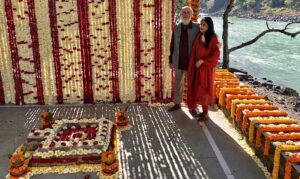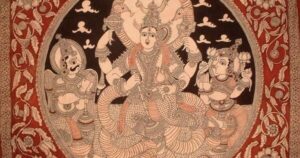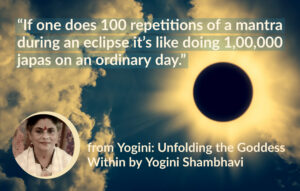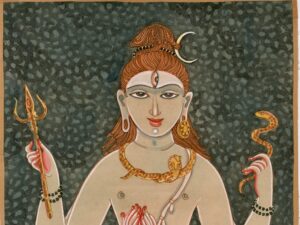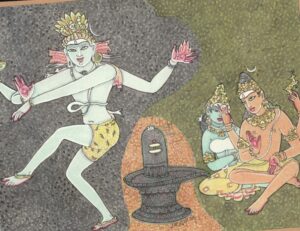
Prana upholds the immunity of both body and mind. This power of prana is not simply the breath, with which it is related, but the deeper vital energy that sustains our entire embodied existence. Prana forms the subtle or energy body of the chakras, which gives life to the physical body, but also transcends it.
Prana Shakti is the key to health, wellbeing and the development of higher awareness on all levels. Today particularly in this pandemic era in which we must wear masks to protect our health, we should also practice more Pranayama at home or in nature to improve our circulation and keep our outer and inner Prana flowing.
Most important for our wellbeing and enlightenment is to have a unified and balanced prana. Ordinarily our prana is divided into dualistic currents of attraction and repulsion through the senses and emotions, much as the mind, which reflects our prana, is divided into dualistic emotional currents and competing thoughts. For health of body or peace of mind, it is necessary to develop a unified and balanced prana at a deep level of awareness. This ultimately involves balancing and deepening all the five pranas (prana, apana, udana, samana, vyana), with their ascending and descending, ingoing and outgoing, expanding and contracting currents. But it begins with the simple balancing the breath between the right and left nostrils.
Keeping the flow of the breath balanced between the right and left nostrils (pingala and ida, nadi shodhana, alternate nostril breathing) protects immunity at an energetic level and calms the mind for meditation. Alternate nostril breathing should be done morning and evening and regularly through the day when our energies get disrupted or dispersed or when they need to be strengthened. Pranic balance leads to balance of mind.
Unitary Prana and Unitary Mind
Unitary prana creates unitary mind. One-pointed (ekagra) prana and one-pointed mind (ekagra chitta) together open all the secrets of Yoga and Samadhi. Keeping a calm, slow, deep and balanced breath brings harmony, integration and coherence to our entire being.
Yet this unitary prana is not a technical matter that can be achieved by mere exercise. Our Prana is our life force, which includes our will power, motivation, aspiration and pursuit of our dharma – ultimately our spirit in life. We need to lead a sattvic life overall according to the sattvic life-regiments of Yoga and Ayurveda in order to achieve this. This includes control of the senses and using them in a contemplative manner, as we easily deplete both our prana and awareness, as well as power of immunity, if our energy is lost through excessive sensory stimulation or disturbance. Unitary focus of the sight at the third eye aids in this process of balancing the mind, while unitary focus of the prana in the navel center complements it.
PRACTICE AYURVEDIC IMMUNITY
Learn about Prana, Tejas and Ojas in Yoga, Ayurveda & Shakti Sadhana through 8 Video Lessons from Dr. David Frawley and Yogini Shambhavi
Prana and Peripheral Circulation relative to Infectious Diseases
Infectious diseases, starting with the common cold and flu, begin with a breakdown of our peripheral pranic circulation along the surface of the body.
This is what we mean and experience by the phrase of ‘catching cold’. Cold constricts the flow of prana, which breaks down the pranic circulation and allows negative energies or pathogens to come into the body and mind. Not only cold, other environmental factors like excess heat, dampness, wind, or any type of bad or toxic air can come into the body once this pranic flow is disrupted. It also weakens the digestive fire that is protected by our pranic circulation. The same external and pathogenic factors affect the digestive fire let in by a weak prana. In addition, the same external and pathogenic factors can disturb the mind and our entire organic equilibrium, extending to disrupting our sleep and blocking our higher awareness.
Pranayama can be practiced to strengthen our peripheral pranic circulation, which makes up our aura and energy field. As long as the pranic flow around the body is continuous and deep, no outside pathogens can enter. Yet this peripheral circulation also depends upon the pranic flow being unimpeded through the spine, supporting it from within. In other words, the peripheral pranic flow is sustained by a central and vertical pranic flow from the root chakra to the top of the head. If there are blockages or impeded circulation along the spine, then the peripheral prana can become weak. If our awareness is not ascending or seeking to rise to a higher state of unity consciousness, then there tends to be a downward and outward movement of prana that causes disharmony and disease for body and mind (excess apana vayu).
Summary
The main factors of Pranayama are to balance, deepen and slow down the breath, drawing it down to the belly and the base of the spine and up to the top of the head as well as around the body as a whole. But this should be done with a connection to the inner unitary Prana that is connected to the power of higher awareness. It must be practiced with mental focus and attention. There are many techniques to work on the prana, but simple alternate nostril breathing is the simplest for balancing our energy. Another simple method is to allow our breath to naturally deepen by internally repeating the mantra SO upon inhalation and HAM upon exhalation. I have examined the role of Prana in detail in my various books like Yoga and Ayurveda and Mantra Yoga and Primal Sound.
Ayurveda Healing examines the role of Prana relative to Vata dosha, with the five types of prana being also the five types of Vata dosha. This is important to know as Vata dosha, apana vayu, and weakened prana are the main factors behind most diseases of body and mind. That is a matter of additional study in Ayurveda.
Through balancing our Prana, immunity is sustained along with a linkage to the healing Prana of nature. This is aided not only by Pranayama practices but by cultivating our spirit in life, our higher Prana and connection to nature and the universal Life. This requires an inner inspiration to seek the Divine within and a devotional aspiration to achieve that connection. These are some of the secrets of Prana Yoga.
Vamadeva Shastri

